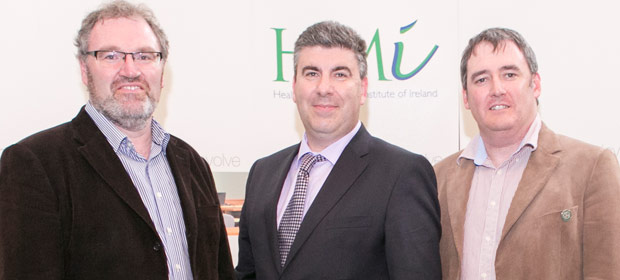The National Integrated Medical Imaging System, (NIMIS) which has connected all public hospitals in Ireland on a single imaging platform, enabling clinicians around the country to share electronic images, resulting in faster and improved diagnosis for patients, won the HMI Major Projects Award. Maureen Browne reports.

The state of the art electronic radiology system has made Ireland’s radiological service “filmless” and enabled secure and rapid movement of patient images data throughout the health service. Doctors can now view their patient’s diagnostic images such as X-rays and CT scans quickly and easily.
The NIMIS project was submitted by Ray Cahill and Michael Fenelon, McKesson Imaging & Workforce Solutions and Prof. Neil O’Hare of Clontarf Hospital.
In 2008, the HSE initiated the NIMIS programme. At that time, there were 52 major hospitals in Ireland’s health service; 37 used traditional film and paper based radiology and 15 sites were using electronic picture archiving communication system (PACS). None of the 15 PACS sites could communicate with each other, so in most cases taxis and couriers were the only way to transport urgent images between hospitals and national specialities centres.
Today NIMIS supports 36,000 medical users in 57 hospitals, archiving 7 million studies, storing over 3 million studies per year on an infrastructure with over 1,000 medical device workstations
NIMIS reached a particular milestone with the go live of Clontarf Hospital, the 40th major site and the 57th hospital in Ireland in April 2016. Clontarf Hospital was the last traditional film-based processing site in Ireland, meaning that all hospitals in the country now have a digital imaging solution.
Now regardless of location, clinicians throughout the healthcare system can share patient imaging data, eliminating loss of medical images and ensuring rapid availability of patient information wherever and whenever it’s needed.
“NIMIS represents a unique solution that offers the world’s largest implementation of a fully resilient national image repository connecting all contracted hospitals through the HSE’s National Health Network. It includes the deployment of McKesson’s medical device imaging workstations, Radiology Information System (RIS), Picture Archiving Communication System (PACS), Voice Recognition Systems and other third party systems,” according to the award winning project .
“The Programme has at its core the installation of a nationally integrated PACS and RIS system spanning the majority of public hospitals in the country – to join all hospitals onto a single database, creating a national enterprise image and report viewing system. This provides significant benefits as no matter where the patient is seen, their imaging records are fully available from any hospital on the system for clinical staff with the appropriate access. The other benefits of a single database include national standardised workflow management and national business intelligence data.”
The requirements involved improving the quality of patient care and introducing one of the biggest changes in Irish healthcare, with targets that included:
- Reduction in Report “Turn-Around” time
- Ability to facilitate remote radiology reporting
- Improved access and availability of patient information
- Fewer repeat examinations
- Cost savings related to X-Ray film usage and management
- Staff savings related to removal or reduction in the need for roles such as dark room attendants, filing clerks and transcriptionists
- Reduction in unreported exams and lost films
- Improved patient data security
- Images follow patient through Care Pathway aiding a more rapid diagnosis / treatment of the patients
- Facilitates reconfiguration of radiology reporting services, including analysis of resources utilisation.
Inaccessibility to patients’ past images and medical information had impeded eHealth progress in the past. Now regardless of location, clinicians throughout the healthcare system can share patient imaging data, eliminating loss of medical images and ensuring rapid availability of patient information wherever and whenever it’s needed, at every stage of the patient journey.
Confidence in the project continues to grow as sites go live. Continued successful deployment of the project, relies on a continuous review process around change management, risk and issue management, responsibilities management and continuous communication and reporting as well as the management of the NIMIS implementation in relation to other projects, both national and local.
This vision represents a significant milestone in the development of a national electronic health record.
The PACS and voice recognition software is one element of the vision. This empowers the medical professionals to access to the diagnosis information they need to care for the patient in a way they could not in the past.
Equally as important, has been the vision of the NIMIS programme to harness the capabilities of hospital staff themselves, throughout all of the public healthcare system, to own the project management, workflow consultancy, testing, training and deployment tasks to deliver an enterprise solution for their hospital.
The implementation of this complex project required an extremely detailed and carefully managed project roll-out and the involvement of hospital management staff, clinical teams and the HSE. The programme sought to bring at least one hospital live per month, so at any one time eight hospitals were at varying stages on the project timeline.
Through NIMIS, radiology services have:
- Reduced report turnaround times
- Provided remote reporting capabilities
- Improved access to and availability of patient information
- Reduced repeat examinations
- Saved costs related to x-ray film usage and management
- Improved patient data security
- Facilitated clinical audits
- Enabled images to follow the patient through the care pathway
- Improved liaison with primary care, and integration with radiation oncology centres
- Developed new methods of departmental communication and cooperation in radiology, standardising processes, e.g. not printing radiology reports and provision of electronic radiology reports to GPs.

